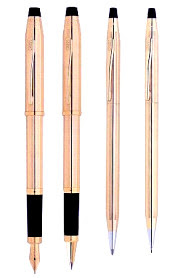 Brand : Cross
Brand : CrossCompany: AT Cross
Brand Count : 195
Cross existed in India for decades. The pen is marketed through UAE based Jashanmal group’s Harmony.Cross is a niche product in the Rs 1600 crore writing instruments market.
Cross became popular in India without any brand promotion. The Pen which adored the pockets of “ Who is Who” did not need advertisements. I remember seeing the ubiquitous golden Cross adoring the pockets of the rich businessmen and executives. When I got my job, I realized my dream of owning a Cross (a silver one) for Rs 875. The most popular Cross is the slim Century Classic,which was launched in 1946 to commemorate the brand’s 100 years.
In the earlier days, the brand was a much sought after brand because there was supply constraints because of import restrictions. Cross was the premium pen available in the market. It competed with Parker and Sheaffers at the premium end. But the stylish design set this brand apart from the competitors.Cross was the preferred gift item for corporate and individuals alike
Now the situation is entirely different. The writing instrument market is witnessing huge competition as well as growth.All the premium brands are now available in the market. Now Cross is no longer considered to be the aspirational brand that position is now taken by Mont Blanc. But Cross has some thing special, the image that it had created not luxury but premium.
Cross all through its life was never a luxury product but it was a Masstige brand even before that ter m was invented. Priced at the range of Rs 875-7500, the TG can afford to buy a Cross by stretching a little.One cannot say that for a Mont Blanc.
m was invented. Priced at the range of Rs 875-7500, the TG can afford to buy a Cross by stretching a little.One cannot say that for a Mont Blanc.
In the Indian market, the brand is now the only affordable premium pen .Parker sadly has diluted itself by offering plastic cheap pens for Rs 50 thereby diluting its equity. Sheaffers is not available in the market and does not have the popularity of Cross.
Cross globally is positioned as a brand for life. The brand is famous for the company’s assurance of repair and replace against any mechanical failure. The product quality is absolutely marvelous .My Cross did not have a single problem even after rough use for more than 8 years. According to a report in Business India Dec 2006 issue, the VP of AT Cross say that the brand’s USP includes Life time guarantee, continuous innovations and ongoing enhancement of product portfolio. Globally this brand is positioned as a preferred gift item.
The brand has extended itself to become a Personal Accessory rather than limiting itself to pens. Cross also has a range of pens for ladies too. The specially designed pens for men include Platinum Plated Verve, Merlot, Cross Townsend,Apogee,Century II, Aventura.The Classic Century still continues to remain a favorite (Source: Business India).
With the Writing Instruments moving away from functionality to Lifestyle,Cross has immense potential in the Indian market. But the low profile existence should pave way for more aggressive marketing and distribution strategy. I came to know only recently that Cross gives a lifetime guarantee.
Related BrandsParker
Source:BusinessIndia,AT cross website









